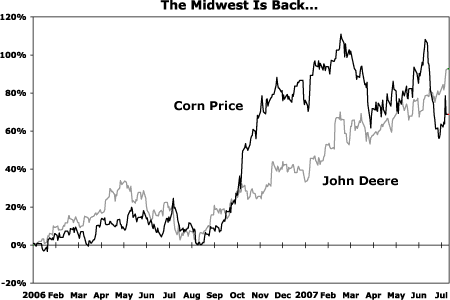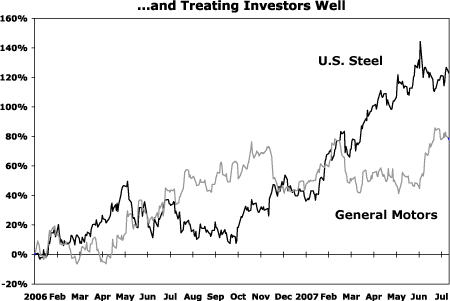| Home | About Us | Resources | Archive | Free Reports | Market Window |
A Great Place For EntrepreneursBy
Friday, July 20, 2007
It's the first rule of economics: Money flows to where it's treated best. I've plotted the stock prices of GM, John Deere, U.S. Steel, and corn. Detroit-based GM is America's largest auto manufacturer. John Deere, based in Illinois, is the largest agricultural equipment manufacturer. The Midwest is famous for steel production – especially Indiana, Ohio, and Pennsylvania – and corn drives the Midwest's economy. Look at these charts and see how the Midwest economy is treating money:
Stock prices of big Midwest companies are rising. Farmland prices have risen four years in a row. How long will it be before Midwest property prices start rising too? "The U.S. population currently stands around 300 million," says Gary North's Reality Check. "But it'll be 400 million by 2050..." "Young people want to own their homes," he continues. "This is not going to change anytime soon. They will move to regions where they can afford to buy a home. They have been doing this since approximately 1640." The coasts have become too expensive for many young families. At the same time, technology lifts incomes in America's heartland as people use the Internet to find new business opportunities. Millions of young families will soon choose to move inland away from the coasts to seek out cheaper property and better job prospects. The politicians encourage it. In New York, Massachusetts, and California, they'll tax and regulate you at every turn. In Detroit, they'll roll out the red carpet, especially if you're fixing up old buildings or bringing jobs. Having the government on your side makes a huge difference to entrepreneurs. Besides, the Midwest has excellent transport links... including canals, railroad lines, Great Lakes shipping, and high-speed freeway networks. And the workforce is educated, too. Last year, Google announced it was investing in a new AdWords headquarters near Ann Arbor, Michigan. Michigan's government helped persuade Google with a $38 million tax credit. The investment will create 2,500 jobs and $2 billion in personal income for Michigan workers. And how about this: Saginaw is Michigan's new Silicon Valley. Hemlock Semiconductor Corp. – a subsidiary of Dow Corning – recently announced a $1 billion expansion near Saginaw. Michael Moore is from Flint, Michigan. The first documentary he ever made was about Flint's economic collapse in the 1980s. Since he made that documentary, things have only gotten worse. GM was headquartered in Flint. GM contributed 5% of U.S. GDP in the 1950s and for many years, was the largest company in the world. In those days, Flint was an extremely prosperous town. Then GM purged 72,000 jobs – from 80,000 jobs in the late 1970s to only 8,000 today. Saginaw had the same problem. So did Troy, Dearborn, and Ann Arbor to some extent. When I asked the folks from Detroit what they thought of Flint and Saginaw, they laughed and dismissed the towns as wrecks. "Oh, there's nothing up there," said one. It helps sooth their pride, I think. The people in Detroit have realized that Saginaw and Flint are the only two places in the world with a worse economy than theirs... and cheaper house prices. (I also heard people in Detroit make fun of towns like Gary, Indiana and Toledo, Ohio.) In yesterday's edition of DailyWealth, I showed you how some of the cheapest property in the world is for sale in Detroit. Right now, the future for Midwest property prices looks rosy to me, despite the extremely depressed prices. If you're an entrepreneurial individual looking for a fresh start in life, consider the Midwest... especially southeastern Michigan. Good investing, Tom
Market Notes98,625 REASONS WHY COPPER PRICES ARE HIGH At last year's New Orleans Investment Conference, the sentiment toward copper was nearly unanimous: China's economy is set to slow down dramatically… which would force copper consumption down... which would force the price of copper much lower. Problem is, unanimous opinions are always wrong. After a brief decline last winter, copper prices are still trading near all-time highs. As far as we can tell, sentiment in the copper market is still the same as it was last year: heavily bearish. And so, we still believe copper prices won't crash anytime soon. The fundamental information backs us up too... Below is a chart of copper prices and copper supplies. As you can see, historically tight supply conditions exist when stocks on the London Metals Exchange are below 200,000 tonnes. Right now, at 98,625 tonnes, copper supplies are still relatively tight. Until this supply/demand situation eases, expect copper prices to remain robust… and expect copper producer stocks to keep soaring.
-Brian Hunt |
Recent Articles
|



